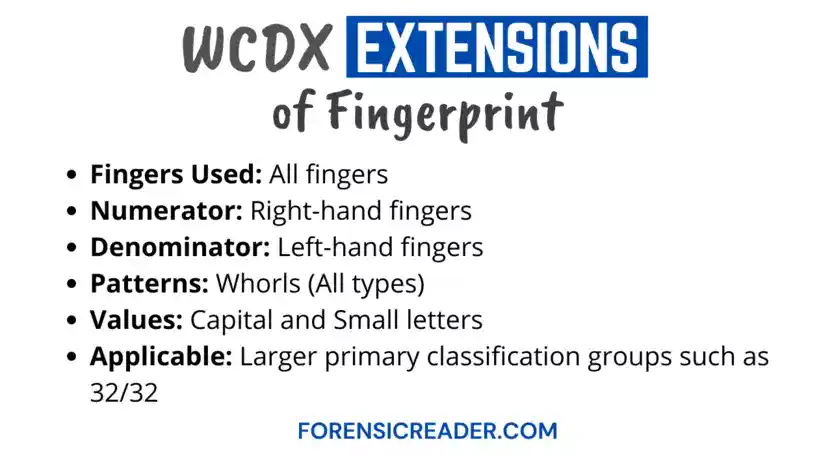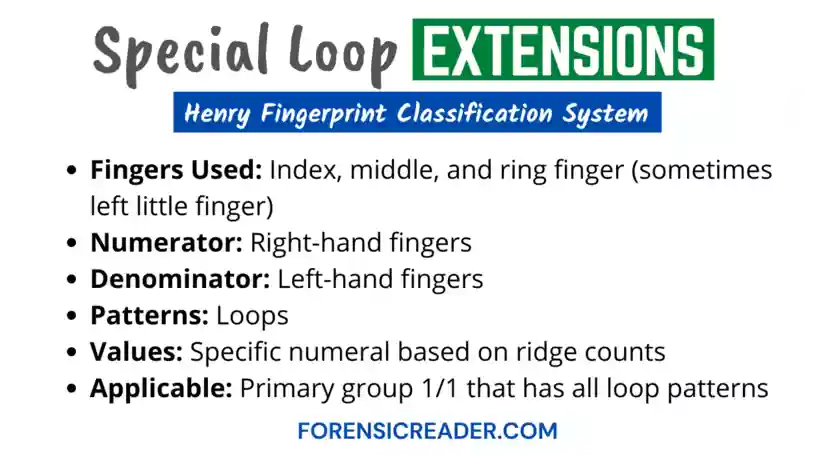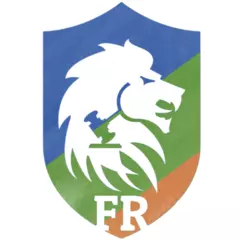Extension to Henry’s fingerprint system is quite a viable way to come up with smaller groups for comparisons. Fingerprint classification extensions are used by various federal agencies to downsize the larger groups making classification systems more efficient and less time-consuming.
To meet the efficiency of searching prints in larger groups databases, many federal agencies come with extensions to further classify Henry’s six divisions system.
In this post, I listed down three extensions that are used by the FBI for their Henry classification system. These are
- WCDX classification
- Special Loops extension
- Second sub secondary classification
WCDX Classification of Fingerprint

WCDX is an acronym for Whorl, Central Pocket, Double, and Accidental loop whorls. It is a special extension majorly used to classify the large groups of whorls patterns such as 32/32.
In this classification, only whorls are classified and named down based on the pattern appearing on all of the fingers.
Rules for WCDX Extension to Henry Classification
- Fingers Used: All fingers
- Numerator: Right-hand fingers
- Denominator: Left-hand fingers
- Position: Above the values of sub secondary classification
- Patterns: Whorls (All types)
- Values: Capital and Small letters
- Applicable: Larger primary classification groups such as 32/32
Value for W.C.D.X. Classification of Fingerprint
As stated earlier, this special extension is used by the FBI for 10 digits that have large whorl groups.
But why only for large whorl groups?
Because, as per the FBI fingerprint database, there are two large primary groups (31/32 and 32/32) of whorls that share a good percentage of 10 digits.
Even after categorizing 32/32 (or 31/32) in Henry’s six divisions, it still has a larger search group size (in millions) that makes comparison impractical.
That’s why they are further subdivided using extensions.
A. Values For Index Finger
For index fingers, capital letters are used as their value.
| Finger Type | Patterns | WCDX Value |
| Index Fingers | Plain Whorl | W |
| Central Pocket Loop Whorl | C | |
| Double Loop whorl | D | |
| Accidental loop whorl | X |
B. Values for All Fingers Except Index
For fingers other than Index, small letter values of different types of whorls are used.
| Finger Types | Patterns | WCDX Value |
| Fingers except, Index | Plain Whorl | w |
| Central Pocket Loop Whorl | c | |
| Double Loop whorl | d | |
| Accidental loop whorl | x |
Calculation for WCDX Classification Value
With the help of the following extracted data from a 10-digit card, let’s find out the WCDX value.

Wonder! why all the markings are in ‘O’, ‘M’, and ‘I’? Check the rules on how to fill 10 digits fingerprint card.
Step 1: Finding Henry Classification Value
I created a dedicated article on how you calculate the values of all six Henry classification systems in no time.
| Key | Major | Primary | Secondary | SubSecondary | Final |
| omitted | O | 32 | W | IMO | 17 |
| I | 32 | W | OMI |
Step 2: Evaluating WCDX Value
| Rt Thumb | Rt Index | Rt Middle | Rt Ring | Rt Little |
| w | C | d | w | c |
| Lt Thumb | Lt Index | Lt Middle | Lt Ring | Lt Little |
| c | W | w | w | x |
Note: Instead of writing ‘ww’, the numerical value of their consecutive occurrence is used. So, it will be written as ‘2w’.
Step 3: Reperesentation of WCDX in Henry Line
This is how WCDX classification rests on Henry’s line.

Practice Set #1 For WCDX Extension

Step 1: Finding Henry Classification Value
| Key | Major | Primary | Secondary | SubSecondary | Final |
| omitted | I | 32 | W | IMM | 17 |
| M | 32 | W | OOI |
Step 2: Evaluating WCDX Value
| Rt Thumb | Rt Index | Rt Middle | Rt Ring | Rt Little |
| w | C | d | x | w |
| Lt Thumb | Lt Index | Lt Middle | Lt Ring | Lt Little |
| c | D | x | w | x |
Step 3: Representation of WCDX in Henry Line
This is how WCDX classification rests on Henry’s line.

Special Loop Extension of Fingerprint

It is used for further classifying 10-digits with all loop patterns— Henry’s primary groups such as 1/1 with all loops. The value of the special loop extension is brought by ridge count values of the index, middle and ring finger (sometimes left little finger) of both hands.
Rules of Using Special Loop Classification
- Fingers Used: Index, middle, and ring finger (sometimes left little finger)
- Numerator: Right-hand fingers
- Denominator: Left-hand fingers
- Position: Above the values of sub secondary classification
- Patterns: Loops
- Values: Specific numeral based on ridge counts
- Applicable: Primary group 1/1 that has all loop patterns
Value for Special Loop Extension of Fingerprint
The following are the values that are assigned based on the ridge counts in the index, middle, and ring fingers.
| Ridge Count | Special Loop Value |
|---|---|
| 1 to 4 | 1 |
| 5 to 8 | 2 |
| 9 to 12 | 3 |
| 13 to 16 | 4 |
| 17 to 20 | 5 |
| 21 to 24 | 6 |
| 25 and more | 7 |
How to Calculate Special Loop Extension’s Value?
With the following 10 digits card information, let find out the value of the special loop extension.

Step 1: Calculating Henry Classification Number
| Key | Major | Primary | Secondary | SubSecondary | Final |
| 9 | S | 1 | U | OII | 12 |
| S | 1 | R | IOI |
You can check the dedicated article on how you come up with the Henry classification number like above.
Step 2: Finding Special Loop Extension Value
Right Hand Loop Counts
- Index= 11= 3 (9 to 12= 3 special loop value)
- Middle= 10= 3
- Ring= 12= 3
Left Hand Loop Counts
- Index= 9= 3 (9 to 12= 3 special loop value)
- Middle= 12= 3
- Ring= 12= 3
Step 3: Representation of Special Extension in Henry Line
This is how special loop extension classification is placed in Henry’s classification line.

Practice #1 For Special Loop Extension

Step 1: Calculating Henry Classification Number
| Key | Major | Primary | Secondary | SubSecondary | Final |
| 15 | S | 1 | U | OOO | 16 |
| L | 1 | R | OOO |
Step 2: Finding Special Loop Extension Value
Right-Hand Loop Counts
- Index= 11= 4 (13 to 16= 4, special loop value)
- Middle= 10= 4
- Ring= 12= 5 (17 to 20= 5, special loop value)
Left-Hand Loop Counts
- Index= 9= 4 (13 to 16= 4, special loop value)
- Middle= 12= 4
- Ring= 12= 4
Step 3: Representation of Special Extension in Henry Line

Second Sub Secondary Classification of Fingerprint
Second Subsecondary classification is majorly used for classifying groups that are too large. You can check the dedicated article on how to calculate secondary sub secondary classification values.
Other General Categorization in Henry Fingerprint System by FBI
For ease during analysis, various ‘reference’ pointers are brought by federal bureaus. These reference categorizing points may be age, gender, dead, and presumptive dead.
Apart from these, amputated and scarred fingers are commonly categorized criteria as references.
In the case of amputated fingers, the reference is given by “AMP”, this is how it looks.
For permanently scarred fingers, the references are divided into 3 groups;
- right hand,
- left hand, and
- both hands
Similarly, for mutilated fingerprints, a separate reference is categorized in employed.
Also Read:
- Second Sub Secondary Classification of Fingerprint: Rules, Procedure & Example
- Final Classification of Fingerprint: Rules, Worksheet, and Amputated Fingers
- Key Classification of Fingerprint: Rules, Procedure, & Example
- National Crime Information Center (NCIC) Fingerprint Classification
- How to Fill and Extract Data From Fingerprint Card? Forensic Fingerprinting

FR Author Group at ForensicReader is a team of Forensic experts and scholars having B.Sc, M.Sc, or Doctorate( Ph.D.) degrees in Forensic Science. We published on topics on fingerprints, questioned documents, forensic medicine, toxicology, physical evidence, and related case studies. Know More.
